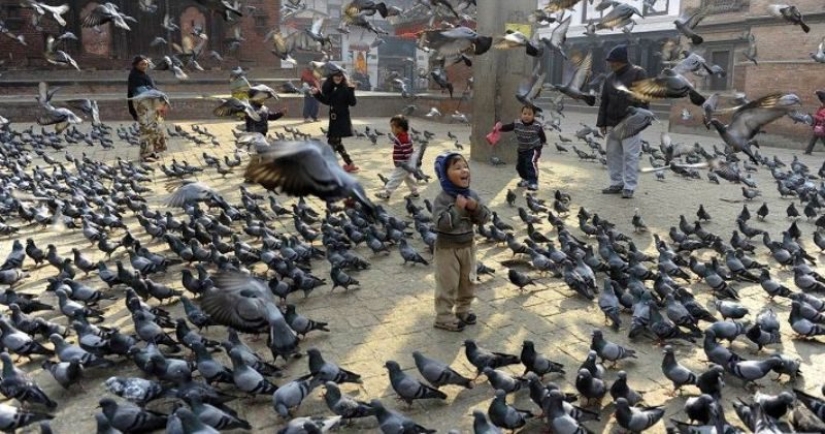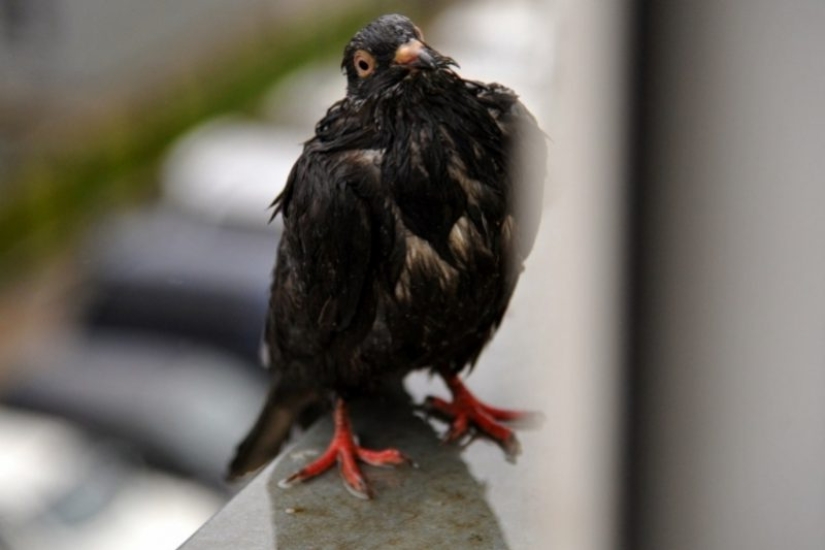City authorities' sanctions against pigeons: what did the bird of the world annoy people with
Categories: Animals | Europe | World
By Pictolic https://pictolic.com/article/city-authorities-sanctions-against-pigeons-what-did-the-bird-of-the-world-annoy-people-with.htmlThe pigeon is a recognized bird of the world. But recently, the feathered inhabitant of city streets and squares is called a flying rat. In many tourist cities in Europe, pigeon feeding is punishable by a fine. For example, Paris and Venice may be forced to pay for loyalty to birds, and in the latter case the fine can be up to 500 euros.

Tourists vacationing in Europe are outraged by the ban on feeding pigeons, and in sunny Magadan, for lack of vacationers, the locals are dissatisfied. Sanctions against urban birds may look cruel and strange, but they are based on iron facts that cannot be ignored.
To begin with, without the help of compassionate passers-by, the extinction of pigeons is not in danger. Even in the capital of the harsh Kolyma Region, where winter reigns for six months, these birds do not feel bad at all and find shelter and food for themselves. The fact is that they are almost omnivorous and can eat grain, seeds, fruits, vegetables, bread. If necessary, pigeons can even peck meat and digest it well.

Such an extensive diet makes these birds regulars of garbage dumps, where you can always profit from some of the above. Where there is waste, there is increased microbial activity, but pigeons do not care about this — the health of these inhabitants of the streets is excellent and even an extensive set of infections and parasites in the body does not prevent them from living a rich pigeon life.
Unfortunately, it is impossible to say the same about a person, but most of the microbes developing in waste pose a danger to us. The list of diseases that pigeons can transmit to humans is very extensive. Here are just a few of the most common options.

Such a disheveled and unhappy pigeon, which immediately wants to help, poses a serious danger to a person. A bird that looks like this is most likely sick with ornithosis, which is easily transmitted to humans. This infection, related to chlamydia, causes severe respiratory illness, sometimes turning into pneumonia.
Today, ornithosis detected in time is successfully eliminated with tetracycline-based drugs, but, again, if treatment is started in a timely manner. In advanced cases, the disease is fraught with severe complications, with damage to the central nervous system, liver, kidneys and lungs. The insidiousness of ornithosis also lies in the fact that the bacteria causing it, Chlamydophila psittaci, live for a long time outside the host's body, for example, in bird droppings.

Salmonellosis is a dangerous intestinal infection that, according to many, enters the human body with substandard products. But it turns out that salmonella has no problems living in the intestines of pigeons, without causing them any discomfort.
Having left the intestines of the bird along with the droppings, salmonella is carried by the wind around and can be anywhere. Scientists have found that it is not difficult to get this infection by airborne droplets. Salmonellosis is not fatal today, but its treatment is long and expensive. In addition, the disease is known for its complications.

Tuberculosis is one of the most common causes of early death worldwide. Pigeons have their own avian tuberculosis, the causative agent of which is Mycobacterium Mycobacterium avium, very similar to the causative agent of classical tuberculosis, dangerous to humans. You can get infected through food and water contaminated with bird fluff.
Infection with this infection is rare, but this does not make the disease less dangerous. Avian tuberculosis affects the human lymphatic and respiratory system, and also causes the appearance of non-healing wounds. With a weakened immune system, even a fatal outcome is possible. The infection is resistant to antibiotics, so it is very difficult to treat.

The fungus cryptococcosis (Cryptococcus neoformans), which is widespread in the environment, loves the soil saturated with bird droppings. A microorganism can enter the human body with food or by airborne droplets. Infected, a person in 30% of cases does not even notice that he was sick with something. But the remaining 70% of the disease proceeds with very serious symptoms, accompanied by fever, cough and even hemoptysis.
In severe cases, hallucinations and severe brain lesions, such as meningitis and meningoencephalitis, are not excluded. Cryptococcosis is treated with antifungal drugs, but sometimes it can turn into a chronic form, in which terrible symptoms persist for months or even years.

The causative agent of histoplasmosis, the fungus Histoplasma capsulatum is not dangerous for pigeons, since they are only its carrier. But for people, infection with this infection is extremely dangerous. Inhaling the spores of the fungus, which are abundant in the soil fertilized with bird droppings, a person can get one of three unpleasant forms of this disease: acute pulmonary, chronic abdominal or diffuse.
Weight loss, severe cough, shortness of breath, ulcers on the mucous membranes, enlargement of the spleen — these are not all the "charms" of this disease. Histoplasmosis, which is also called Darling's disease, can even lead to death, especially if a child or an elderly person is ill with it.

The list of infections carried by pigeons can be continued for a very long time. This should also include several types of ticks, which almost every bird has. They cannot live on the human body, but they are quite capable of biting through the skin and causing an infected wound or dermatitis.
It is quite difficult to get infected with something from a pigeon that just wanders nearby or lives on a balcony. The risk group includes people engaged in their maintenance and breeding, as well as those tourists who are happy to feed the birds with their hands.
After the pigeon has eaten bread or grain from the palm of the hand, people, especially children, are in no hurry to wash or disinfect them. With food or just touching your face, you can become the owner of one or even several diseases from a solid "pigeon" list. Another, less common variant of infection is airborne. With the dust raised by the wings of pigeons, a person can inhale pathogens and, seriously ill, is unlikely to understand what he suffered from.

But this is not all the troubles associated with our feathered neighbors. A huge problem is created by their droppings, which accumulate in attics, architectural elements of architectural monuments and monuments. Pigeon droppings themselves are quite chemically aggressive and, with prolonged exposure, can damage even metal. Is it worth reminding how ugly monuments and car hoods smeared with white streaks look.
The story of how a dove damaged a Renaissance masterpiece in Milan, the cost of which exceeded $ 4 million, is well known. But this is unlikely to upset you more than a snow-white blouse or a stylish hairstyle spoiled by bird feces.
It has already been estimated that a flock of only 100 pigeons produces more than two tons of litter per year. Considering the number of these birds in cities such as Rome, Paris, Florence or Moscow, it becomes clear that this is also a serious problem. In some European cities, even attempts are being made to protect buildings from "flying rats". To do this, the cornices of houses and tree branches are provided with special spikes that prevent birds from using them as a roost.

In houses with attics, where pigeon families nest for years, a huge amount of litter accumulates, in which insects swarm and fungi and bacteria multiply without interference. A visit to such an attic without protective equipment can be dangerous to health. And now think that all this is happening right over your heads, in some cases only 2-2.5 meters away from you.
Feeding urban pigeons, we do not so much care about them, as we aggravate the already difficult situation with these birds. Without difficulty getting food, flocks of birds grow by leaps and bounds, disfiguring monuments with waste products and worsening the epidemiological situation.

It is impossible to destroy pigeons — these are living creatures that have been living next to humans for more than 6 thousand years. These birds have many natural enemies that regulate their population both in cities and in rural areas. But by providing them with food in unlimited quantities, we disrupt the fragile natural balance and encourage the already numerous birds to reproduce at an accelerated pace.
Recent articles

Everyone has the right to choose the lifestyle they like. US resident Manders Barnett has been living in a tent all year round for ...

Everyone knows that village girls are special. They almost do not use cosmetics, rarely visit beauty salons and do not visit ...

The high—altitude Grossglockner road is one of the most beautiful in the Alps. It connects the Austrian lands of Salzburg and ...